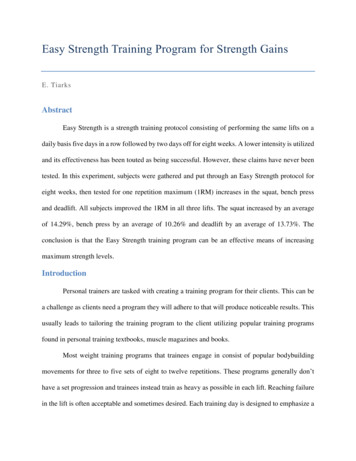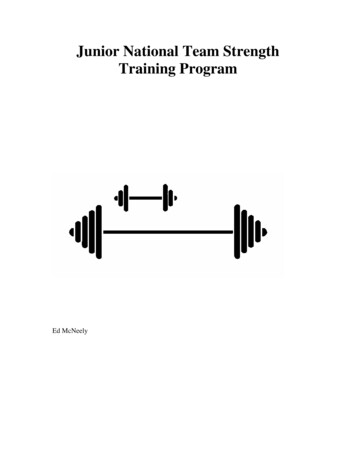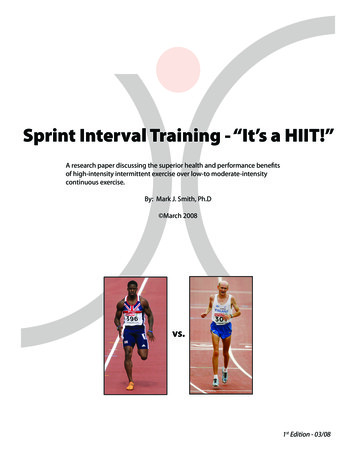
Transcription
Easy Strength Training Program for Strength GainsE. TiarksAbstractEasy Strength is a strength training protocol consisting of performing the same lifts on adaily basis five days in a row followed by two days off for eight weeks. A lower intensity is utilizedand its effectiveness has been touted as being successful. However, these claims have never beentested. In this experiment, subjects were gathered and put through an Easy Strength protocol foreight weeks, then tested for one repetition maximum (1RM) increases in the squat, bench pressand deadlift. All subjects improved the 1RM in all three lifts. The squat increased by an averageof 14.29%, bench press by an average of 10.26% and deadlift by an average of 13.73%. Theconclusion is that the Easy Strength training program can be an effective means of increasingmaximum strength levels.IntroductionPersonal trainers are tasked with creating a training program for their clients. This can bea challenge as clients need a program they will adhere to that will produce noticeable results. Thisusually leads to tailoring the training program to the client utilizing popular training programsfound in personal training textbooks, muscle magazines and books.Most weight training programs that trainees engage in consist of popular bodybuildingmovements for three to five sets of eight to twelve repetitions. These programs generally don’thave a set progression and trainees instead train as heavy as possible in each lift. Reaching failurein the lift is often acceptable and sometimes desired. Each training day is designed to emphasize a
particular body part (such as chest, legs, etc.) with multiple exercises performed for the body part.Usually, a few days to a week is used for recovery prior to training that body part again (ACSM2009).Other training programs, such as those used by competitive powerlifters, are morescientific in nature. They usually consist of a six to eight week percentage based program thattapers to a peak for a competition or leads to another goal in the training process. Weights usedare usually a varying percentage of the trainee’s one rep maximum (1RM), with reps and sets thatvary in both intensity and volume. This type of program is most likely biased toward two to fourmain or competition lifts utilizing a range of 65-95% of 1RM. A few selected assistancemovements may be used to complement the main lifts. The main lifts are performed once or twiceper week with three to seven days off for recovery. These types of programs usually include a backoff week four to six weeks into the program to help aid recovery and adaptation (Wendler 2009).For this experiment, the Easy Strength training program by Dan John and Pavel Tsatsoulinewas selected. Easy Strength is a 40 workout, eight week program consisting of five training daysin a row followed by two days off (John, et al., 2011). The same lifts are performed each day, buta lower intensity is used so the trainee has a rate of perceived exertion (RPE) around five or six ona ten point scale. The weight should be light enough that there is no need to get ‘psyched up’ inorder to perform the lift. Additionally, the trainee should never miss a rep and each lift will beperformed with a total of ten reps or less in various rep/set schemes.Whether or not using the same lifts on a daily basis with a lower intensity is effective has not beenanswered. This experiment tests the program in order to assess the effectiveness of the EasyStrength training program. Subjects were selected and put through the 40 workout trainingprogram, then assessed in the “big three” lifts, consisting of the squat, bench press and deadlift.-2-
Materials and MethodsNine subjects of varying height, weight and training background were selected. Each of thesubjects was given instruction on proper form in each of the lifts to be performed during the eightweeks. The subjects were then tested in the one rep maximum (1RM) in the squat, bench press anddeadlift. The 1RM numbers were then used to populate a Google Docs spreadsheet withpercentages of the 1RM used to calculate poundages for the lifts the subjects performed.The subjects were given the Google Docs spreadsheet to use as a schedule for each training day(Fig. 1). The spreadsheet was separated into two-week blocks. Each week long block consisted offive workout days followed by two days off for a total of ten workouts in each two-week block.The ten workouts consisted of the following set/rep scheme for each of the three lifts, as well aspullups:Days 1 and 2: 2 sets of 5 reps with the starting percentage of 1RMDay 3: 1 set of 5, add weight for a set of 3, add a little more weight for a set of 2Days 4, 5 and 6: 2 sets of 5 repsDay 7: 6 singles, adding weight with each successive set.Day 8: de-load with 1 set of 10Day 9: 2 sets of 5 repsDay 10: 1 set of 5, add weight for a set of 3, add a little more weight for a set of 2Weights for each lift were calculated using a percentage of 1RM, called the startingpercentage, for each two week block. This number was gradually increased in small percentageincrements throughout each two week block. For the days utilizing 2 sets of 5 reps, the percentageincrement was graduated so that Day 9 was utilizing 7.5% more weight than day 1. For Day 3, Set1 started at starting percentage while Set 2 added 10% and Set 3 added 12.5%. Day 7 consists of-3-
six sets of singles. This day started with the weight utilized on Day 6 and gradually incrementedso that Set 6 was 30% heavier than Set 1. Day 8 utilized weights that were 5% lower than thestarting percentage for the two week block. On Day 10, Set 1 started at the weight utilized on Day9 while Sets 2 and 3 utilized 10% and 12.5% more weight, respectively. After each two weekblock, the starting percentage was incremented by 2.5% and the cycle repeated.A loaded carry that varied in load and distance each day, as well as abdominal wheelrollouts were also included on the spreadsheet. These were varied subtly in intensity each day.Table 1Four two-week blocks were utilized for a total of eight weeks (40 workouts).Weeks 1 and2 utilized a starting percentage of 55% 1RM. Weeks 3 and 4 started with 60% 1RM, weeks 5 and6 started with 62.5% 1RM and weeks 7 and 8 started with 67.5% 1RM.After completion of the eight week program, each subject was again tested for a 1RM andthe numbers were recorded. Each client was interviewed in order to assess client adherence to theprogram, perceived effort and satisfaction.-4-
ResultsEvery subject had an increase in strength in each of the three lifts. Squat improved by an averageof 30 pounds (13.95%) with a low of 5lbs and a high of 60 lbs. Bench press improved by an averageof 15 pounds (7.89%) with a low of 5lbs and a high of 30lbs. Deadlift improved by an average of40lbs (15.38%) with a low of 15lbs and a high of 60lbs (Figures 1, 2 and 3).Average igure 1-5-
Poundage rageFigure 2Percent wHighAverageFigure 3-6-
DiscussionResults were positive for all subjects, leading to the conclusion that the Easy Strengthprogram utilizing the same lifts per day with a lower intensity can be an effective strength trainingprogram. Subject adherence was good due to the program being relatively quick and easy toperform. One hundred percent of the subjects were happy with their results. Multiple subjectsremarked that the program felt “too easy” and was sometimes “boring”. However, these subjectswere also “surprised” at the effectiveness. While each subject had a different training background,all subjects were active at the time and utilizing a training program they designed themselves. Allwere previously unhappy with the results they were getting and felt the Easy Strength programprovided results they were looking for.Without further study, it can only be theorized as to why this program was effective. Themost likely mechanism for the strength gain was neurological adaptation. With the same liftperformed on a daily basis, neurological adaptation will lead to increased “skill” at performing themovement (Tsatsouline 1999; Tsatsouline 2004). This could lead to higher motor unit recruitmentor more synergistic motor unit recruitment (Duchateau, Enoka and Semmler 2006).While the lifts were performed daily, a lower intensity was used in the form of weights ata lower percentage of 1RM. This resulted in a low daily volume, helping to prevent excessivemuscle fatigue and allowing for a faster recovery and adaptation (Tsatsoline 1999). Subjectsreported only minor muscle soreness that reduced as the program progressed, indicating lessinflammation and therefore less muscle tissue breakdown. Further studies on this would be neededto validate this theory.-7-
While the daily volume was low, the weekly volume for each lift was relatively high. Manypopular training programs utilize high volume in order to elicit an adaptation response in the formof either hypertrophy or strength gains. The high volume is usually accrued in one or two daysduring the workout week at higher intensities (ACSM 2009), although in some cases it is accruedvia more frequent training sessions (Poliquin 2010). In this case, it was accrued over five days. Asthe intensities were lower, the body may have been able to adapt more efficiently than in otherhigh weekly volume programs. However, a comparison study would be needed to validate thishypothesis.ConclusionBased on the results of this experiment, the Easy Strength training program is an effectivemeans to elicit strength gains in both trained and untrained individuals. It is easy to program,implement and sustain, making it a high value program to be implemented by personal trainers fortheir clients.References[ACSM] American College of Sports Medicine. 2009. American College of Sports Medicineposition stand: Progression models in resistance training for healthy adults. Medicine & Sciencein Sports & Exercise. 41(3); 687-708.Duchateau J, Enoka RM, Semmler J. 2006. Training adaptations in the behavior of human motorunits. Journal of Applied Physiology 101(6); 1766-1775.John D, Tsatsouline P. 2011. Easy Strength. St. Paul, MN : Dragon Door Publications, Inc.-8-
Poliqiun C. 2010. German Volume Training: A new look at an old way to get big and /ArticlesMultimedia/Articles/Article/441/German Volume Training.aspx.Tsatsouline P. 1999. Power to the People. St. Paul, MN : Dragon Door Publications, Inc.Tsatsouline P. 2004. The Naked Warrior. St. Paul, MN : Dragon Door Publications, Inc.Wendler J. 2009. 5/3/1: The Simplest and Most Effective Training System to Increase RawStrength. s.l. : Jim Wendler LLC, 2009.-9-
off week four to six weeks into the program to help aid recovery and adaptation (Wendler 2009). For this experiment, the Easy Strength training program by Dan John and Pavel Tsatsouline was selected. Easy Strength is a 40 workout, eight week program consisting of five training days in a row followed by two days off (John, et al., 2011). The same lifts are performed each day, butFile Size: 441KBPage Count: 9











